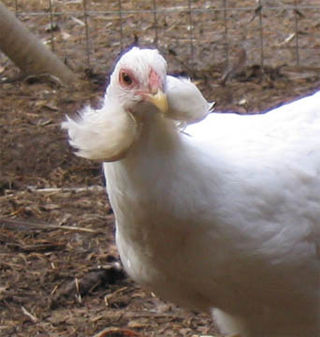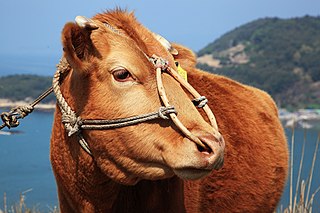
Poultry are domesticated birds kept by humans for the purpose of harvesting animal products such as meat, eggs or feathers. The practice of raising poultry is known as poultry farming. These birds are most typically members of the superorder Galloanserae (fowl), especially the order Galliformes. The term also includes waterfowls of the family Anatidae but does not include wild birds hunted for food known as game or quarry.

The chicken is a large and round short-winged bird, domesticated from the red junglefowl of Southeast Asia around 8,000 years ago. Most chickens are raised for food, providing meat and eggs; others are kept as pets or for cockfighting.

Animal husbandry is the branch of agriculture concerned with animals that are raised for meat, fibre, milk, or other products. It includes day-to-day care, management, production, nutrition, selective breeding, and the raising of livestock. Husbandry has a long history, starting with the Neolithic Revolution when animals were first domesticated, from around 13,000 BC onwards, predating farming of the first crops. By the time of early civilisations such as ancient Egypt, cattle, sheep, goats, and pigs were being raised on farms.

The Araucana is a breed of domestic chicken from Chile. Its name derives from the Araucanía region of Chile where it is believed to have originated. It lays blue-shelled eggs, one of very few breeds that do so.

The red junglefowl, also known as the Indian red junglefowl, is a species of tropical, predominantly terrestrial bird in the fowl and pheasant family, Phasianidae, found across much of Southeast and parts of South Asia. The red junglefowl was the primary species to give-rise to today's many breeds of domesticated chicken ; additionally, the related grey junglefowl, Sri Lankan junglefowl and the Javanese green junglefowl have also contributed genetic material to the gene pool of the modern chicken.

A capon is a male chicken that has been castrated or neutered, either physically or chemically, to improve the quality of its flesh for food, and, in some countries like Spain, fattened by forced feeding.

The domestication of vertebrates is the mutual relationship between vertebrate animals including birds and mammals, and the humans who have influence on their care and reproduction.
Gamebird hybrids are the result of crossing species of game birds, including ducks, with each other and with domestic poultry. These hybrid species may sometimes occur naturally in the wild or more commonly through the deliberate or inadvertent intervention of humans.

The Legbar is a rare British auto-sexing breed of chicken. It was created in the early twentieth century by Reginald Crundall Punnett and Michael Pease at the Genetical Institute of Cambridge University. They cross-bred American barred Plymouth Rock birds with brown Leghorns and created the gold and silver colour varieties. Pease created a cream Legbar by cross-breeding these with white Leghorns; later crossing with Araucanas caused this to have a crest and to lay blue or blue-green eggs.

The Sebright is a British breed of bantam chicken. It is a true bantam – a miniature bird with no corresponding large version – and is one of the oldest recorded British bantam breeds. It is named after Sir John Saunders Sebright, who created it as an ornamental breed by selective breeding in the early nineteenth century.

The Hanwoo, also Hanu or Korean Native, is a breed of small cattle native to Korea. It was formerly used as a working animal, but is now raised mainly for meat. It is one of four indigenous Korean breeds, the others being the Chikso, the Heugu and the Jeju Black.

The Asil or Aseel is an Indian breed or group of breeds of game chicken. It is distributed in much of India, particularly in the states of Tamil Nadu, Andhra Pradesh, Chhattisgarh and Odisha; it has been exported to several other countries. Similar fowl are found throughout much of Southeast Asia.

Solid black plumage color refers to a plumage pattern in chickens characterized by a uniform, black color across all feathers. There are chicken breeds where the typical plumage color is black, such as Australorp, Sumatra, White-Faced Black Spanish, Jersey Giant and others. And there are many other breeds having different color varieties, which also have an extended black variety, such as Leghorn, Minorca, Wyandotte, Orpington, Langshan and others.

Koen Vanmechelen is a Belgian artist who began his career in the early 1990s. Central to his work is the concept of bio-cultural diversity, which he investigates through the domestic chicken and its ancestral species, the red junglefowl or Gallus gallus.

The Bresse Gauloise is a French breed of domestic chicken. It originates in the historic region and former province of Bresse, in the regions of Rhône-Alpes, Bourgogne and Franche-Comté, in eastern France. Because of legal restrictions on the use of the name, only white chickens raised within that area may be called "Bresse"; outside it, they are given the name "Gauloise"; the breed name combines both. Four colours are recognised for the Bresse Gauloise, three of them linked to areas within Bresse: the Bresse de Bourg is "grey" (silver-pencilled); the Bresse de Bény is white; the Bresse de Louhans is black; and a blue variety has recently been created. White Bresse de Bény chickens and capons raised in the area of Bresse have appellation d'origine contrôlée status and are marketed as poulet de Bresse; they are regarded as a premium product and command higher prices than other chickens.

The Alsacienne or French: Poule d'Alsace is a breed of domestic chicken from Alsace, in eastern France. It was selectively bred in the 1890s, at a time when Alsace was part of the German Empire. Unlike most other French breeds, it has not been cross-bred with imported Oriental stock.

Animal genetic resources for food and agriculture (AnGR), also known as farm animal genetic resources or livestock biodiversity, are genetic resources of avian and mammalian species, which are used for food and agriculture purposes. AnGR is a subset of and a specific element of agricultural biodiversity.
The Yakido is a Japanese breed of fighting chicken. It belongs to the Shamo group of breeds. It was bred in the Kansai region in southern Honshu in the mid-nineteenth century. It was made a Natural Monument of Japan in 1950.

The Krüper is a German breed of creeper chicken. It originates in the former Duchy of Berg, now the Bergisches Land in western Germany, and is one of three chicken breeds from that area, the others being the Bergische Kräher and the Bergische Schlotterkamm. It belongs to the group of original European creeper breeds. The breed has normal-sized and bantam varieties.

















